UNIT:Traditional Family Life
Introductory activity: Read the following text and answer
questions below:
Health dietWhat is a healthy diet?
Eating a healthy diet is not about strict limitations, staying unrealistically
thin, or depriving yourself of the foods you love. Rather, it’s about
feeling great, having more energy, improving your health, and boosting
your mood.
Healthy eating doesn’t have to be overly complicated. If you feel
overwhelmed by all the conflicting nutrition and diet advice out there,
you’re not alone. It seems that for every expert who tells you a certain
food is good for you, you’ll find another saying exactly the opposite. The
truth is that while some specific foods or nutrients have been shown to
have a beneficial effect on mood, it’s your overall dietary pattern that is
most important. The cornerstone of a healthy diet should be to replaceprocessed food with real food whenever possible.
Eating food that is as close as possible to the way nature made it can make
a huge difference to the way you think, look, and feel.
The fundamentals of healthy eating
While some extreme diets may suggest otherwise, we all need a balance
of protein, fat, carbohydrates, fiber, vitamins, and minerals in our diets
to sustain a healthy body. You don’t need to eliminate certain categories
of food from your diet, but rather select the healthiest options from each
category.
Protein gives you the energy to get up and go—and keep going—while
also supporting mood and cognitive function. Too much protein can be
harmful to people with kidney disease, but the latest research suggests
that many of us need more high-quality protein, especially as we age.
That doesn’t mean you have to eat more animal products—a variety of
plant-based sources of protein each day can ensure your body gets all the
essential protein it needs. Most animal sources of protein, such as meat,
poultry, fish, eggs, and dairy, deliver all the amino acids your body needs,
while plant-based protein sources such as grains, beans, vegetables, and
nuts often lack one or more of the essential amino acids.
Fat. Not all fat is the same. While bad fats can wreck your diet and increase
your risk of certain diseases, good fats protect your brain and heart. In fact,
healthy fats—such as omega-3s—are vital to your physical and emotional
health. Including more healthy fat in your diet can help improve your
mood, boost your well-being, and even trim your waistline.
What are dietary fats?
Fat is a type of nutrient, and just like protein and carbohydrates, your body
needs some fat for energy, to absorb vitamins, and to protect your heart and
brain health. For years we’ve been told that eating fat will add inches to
your waistline, raise cholesterol, and cause a myriad of health problems.
But now we know that not all fat is the same.
“Bad” fats, such as artificial trans fats and saturated fats, are guilty of
the unhealthy things all fats have been blamed for—weight gain, clogged
arteries, an increased risk of certain diseases, and so forth. But “good” fatssuch as unsaturated fats and omega-3 fatty acids have the opposite effect.
In fact, healthy fats play a huge role in helping you manage your moods, stay
on top of your mental game, fight fatigue, and even control your weight.
NB: Saturated fat occurs naturally in red meat and dairy products. It’s also
found in baked goods and fried foods. Trans fat occurs naturally in small
amounts in red meat and dairy products. Trans fat can also be manufactured
by adding hydrogen to vegetable oil.
Dietary fat and cholesterol
Dietary fat plays a major role in your cholesterol levels. Cholesterol is a
fatty, wax-like substance that your body needs to function properly. In and
of itself, cholesterol isn’t bad. But when you get too much of it, it can have
a negative impact on your health. As with dietary fat, there are good and
bad types of cholesterol.
• High-Density Lipoprotein (HDL) cholesterol is the “good” kind of
cholesterol found in your blood.
• Low-Density Lipoprotein (LDL) cholesterol is the “bad” kind.
• The key is to keep LDL levels low and HDL high, which may protect
against heart disease and stroke.
• Conversely, high levels of LDL cholesterol can clog arteries and low
HDL can be a marker for increased cardiovascular risk.
Rather than the amount of cholesterol you eat, the biggest influence on your
cholesterol levels is the type of fats you consume. So instead of counting
cholesterol, it’s important to focus on replacing bad fats with good fats.
Healthy or “good” fats
Monounsaturated fats and polyunsaturated fats are known as the
“good fats” because they are good for your heart, your cholesterol, and
your overall health. These fats can help to:
• Lower the risk of heart disease and stroke.
• Lower bad LDL cholesterol levels, while increasing good HDL.
• Prevent abnormal heart rhythms.
• Lower triglycerides associated with heart disease and fight
inflammation.
• Lower blood pressure.
• Prevent atherosclerosis (hardening and narrowing of the arteries).
Adding more of these healthy fats to your diet may also help to make
you feel more satisfied after a meal, reducing hunger and thus promoting
weight loss.
Monounsaturated fat – good sources include:
• Olive, canola, peanut, and sesame oils
• Avocados
• Olives
• Nuts (almonds, peanuts, macadamia, hazelnuts, pecans, cashews)
• Peanut butter
Polyunsaturated fat – good sources include:
• Sunflower, sesame, and pumpkin seeds
• Flaxseed
• Walnuts
• Fatty fish (salmon, tuna, mackerel, herring, trout, sardines) and fish oil
• Soybean and safflower oil
• Soymilk
• Tofu
Unhealthy or “bad” fats
Trans fat. Small amounts of naturally occurring trans fats can be found
in meat and dairy products but it’s artificial trans fats that are considered
dangerous. This is the worst type of fat since it not only raises bad LDL
cholesterol but also lowers good HDL levels. Artificial trans fats can also
create inflammation, which is linked to heart disease, stroke, and other
chronic conditions and contributes to insulin resistance, which increases
your risk of developing Type 2 diabetes.
Trans fat – primary sources include:
• Commercially-baked pastries, cookies, doughnuts, muffins, cakes,
pizza dough
• Packaged snack foods (crackers, microwave popcorn, chips)
• Stick margarine, vegetable shortening
• Fried foods (French fries, fried chicken, chicken nuggets, breaded fish)
• Anything containing hydrogenated or partially hydrogenated vegetableoil, even if it claims to be “trans fat-free”
Saturated fat. While not as harmful as trans fat, saturated fat can raise bad
LDL cholesterol and too much can negatively impact heart health, so it’s
best consumed in moderation. While there’s no need to cut out all saturated
fat from your diet, most nutrition experts recommend limiting it to 10% of
your daily calories.
Saturated fat – primary sources include:
• Red meat (beef, lamb, pork)
• Chicken skin
• Whole-fat dairy products (milk, cream, cheese)
• Butter
• Ice cream
• Lard
• Tropical oils such as coconut and palm oil
Fiber. Eating foods high in dietary fiber (grains, fruit, vegetables, nuts,
and beans) can help you stay regular and lower your risk for heart disease,
stroke, and diabetes. It can also improve your skin and even help you to
lose weight. It may even help prevent colon cancer. Many different studies
have highlighted how eating a diet high in fiber can boost your immunesystem and overall health
High-Fiber Foods
What is fiber?
Fiber, also known as roughage, is the part of plant-based foods (grains,
fruits, vegetables, nuts, and beans) that the body can’t break down. It passes
through the body undigested, keeping your digestive system clean and
healthy, easing bowel movements, and flushing cholesterol and harmful
carcinogens out of the body.
Fiber comes in two varieties: insoluble and soluble.
Insoluble fiber does not dissolve in water. It is the bulky fiber that helps
to prevent constipation, and is found in whole grains, wheat cereals, and
vegetables such as carrots, celery, and tomatoes.
Soluble fiber dissolves in water and helps control blood sugar levels and
reduce cholesterol. Good sources include barley, oatmeal, beans, nuts, and
fruits such as apples, berries, citrus fruits, and pears.
Many foods contain both soluble and insoluble fiber. In general, the more
natural and unprocessed the food, the higher it is in fiber. There is no fiber
in meat, dairy, or sugar. Refined or “white” foods, such as white bread,
white rice, and pastries, have had all or most of their fiber removed.
The health benefits of fiber
Digestive health. Dietary fiber normalizes bowel movements by bulking
up stools and making them easier to pass. This can help relieve and prevent
both constipation and diarrhea. Eating plenty of fiber can also reduce
your risk for diverticulitis (inflammation of the intestine), hemorrhoids,
gallstones, kidney stones, and provide some relief for irritable bowel
syndrome (IBS). Some studies have also indicated that a high-fiber diet
may help to lower gastric acid and reduce your risk for gastroesophageal
reflux disorder (GERD) and ulcers.
Diabetes. A diet high in fiber—particularly insoluble fiber from cereals—
can lower your risk for type 2 diabetes. If you already have diabetes, eating
soluble fiber can slow the absorption of sugar and improve your blood
sugar levels.
Cancer. There is some research that suggests eating a high-fiber diet
can help prevent colorectal cancer, although the evidence is not yet
conclusive. Diets rich in high-fiber foods are also linked to a lower risk for
other common digestive system cancers, including stomach, mouth, and
pharynx.
Skin health. When yeast and fungus are excreted through the skin, they
can trigger outbreaks or acne. Eating fiber, especially psyllium husk (a
type of plant seed), can flush toxins out of your body, improving the health
and appearance of your skin.
Heart health. Fiber, particularly soluble fiber, is an important element of
any heart-healthy diet. Eating a diet high in fiber can improve cholesterol
levels by lowering LDL (bad) cholesterol. A high fiber intake can also
reduce your risk for metabolic syndrome, a group of risk factors linked
to coronary heart disease, diabetes, and stroke. Fiber can also help tolower blood pressure, reduce inflammation, improve levels of HDL (good)
cholesterol, and shed excess weight around the abdomen.
Fiber and weight loss
By regulating your blood sugar levels, it can help maintain your body’s fat
burning capacity and avoid insulin spikes that leave you feeling drained
and craving unhealthy foods.
Eating plenty of fiber can move fat through your digestive system at a
faster rate so that less of it can be absorbed.
When you fill up on high-fiber foods such as fruit, you’ll also have more
energy for exercising.
Calcium. As well as leading to osteoporosis, not getting enough calcium in
your diet can also contribute to anxiety, depression, and sleep difficulties.
Whatever your age or gender, it’s vital to include calcium-rich foods in
your diet, limit those that deplete calcium, and get enough magnesium
and vitamins D and K to help calcium do its job. In general rich sources of
magnesium are greens, nuts, seeds, dry beans, whole grains, wheat germ,
wheat and oat bran.
Sources of calcium:
• milk, cheese and other dairy foods.
• green leafy vegetables – such as curly kale, okra but not spinach
(spinach does contain high levels of calcium but the body cannot
digest it all)
• soya drinks with added calcium.
• bread and anything made with fortified flour.
lcium is a key nutrient that many of us overlook in our diets. Almost
every cell in the body uses calcium in some way, including the nervous
system, muscles, and heart. Your body uses calcium to build healthy
bones and teeth, keep them strong as you age, send messages through the
nervous system, help your blood clot, your muscles contract, and regulate
the heart’s rhythm.
If you don’t get enough calcium in your diet, your body will take it from
your bones to ensure normal cell function, which can lead to weakened
bones or osteoporosis. Calcium deficiency can contribute to mood problems
such as irritability, anxiety, depression, and difficulty sleeping.
Despite these vital functions, many of us are confused about calcium and
how to best protect our bones and overall health. How much calcium
should you get? Where should you get it? And what’s the deal with vitamin
D, magnesium, and other nutrients that help calcium do its job? This
confusion means that many of us are not getting the recommended daily
amount of calcium and approximately one in two women (and about one in
four men) over the age of 50 will break a bone due to osteoporosis.
Getting enough calcium in your diet is not just important for older people.
It’s also vital for children, teens, and young adults since we continue
building bone mass into our mid-20s. From then on, we can lose bone
mass without sufficient calcium in our diets.
The calcium and osteoporosis connection
Osteoporosis is a “silent” disease characterized by loss of bone mass.
Due to weakened bones, fractures become commonplace, which leads to
serious health risks. People with osteoporosis often don’t recover after a
fall and it is the second most common cause of death in women, mostly
those aged 60 and older. Men are also at risk of developing osteoporosis,
but typically 5 to 10 years later than women. For most people, osteoporosis
is preventable, and getting enough calcium in your diet is the first place to
start.
Carbohydrates are one of your body’s main sources of energy. But most
should come from complex, unrefined carbs (vegetables, whole grains,
fruit) rather than sugars and refined carbs. Cutting back on white bread,
pastries, starches, and sugar can prevent rapid spikes in blood sugar,
fluctuations in mood and energy, and a build-up of fat, especially around
your waistline.Adapted from https://www.helpguide.org/articles/healthy-eating/healthy
eating.htm retrieved on 8th September 2021.
Comprehension questions
1. What do you understand by “eating a healthy diet”?
2. Identify different types of nutrients found in various food types.
3. What are the fundamentals of healthy eating?
4. Explain the difference between good and bad fat; good and badcholesterol.
Vocabulary practice
Use each of the following words in your own sentence.
1. depriving
2. boosting
3. overwhelmed
4. cornerstone
5. amino acids
6. artificial trans fats
7. saturated fats
8. triglycerides
9. inflammation
10.atherosclerosis
11.colon cancer
12.bulking up
13.colorectal cancer
14.yeast
15.metabolic syndrome
16.coronary heart disease
17.diabetes
18.stroke
19.osteoporosis20.fluctuations
Application
Debate on the following motion:Only rich people can eat healthy food.
Describing one’s extended family
Language use
Activity 1
Discussion
Discuss these questions.
1. Share with your group members the people who live in your family.
2. Who is the head of your family and what are his or her roles?3. Do you think living in a family is important? Explain your views.
Listening practice
Activity 2
(Textbook closed)Your teacher will read for you a
passage. Listen carefully and answer the questions that
follow.
The Traditional African Family
The subject of “traditional family patterns in Africa” is so broad that it
cannot be adequately addressed in one chapter. The cultural and physical
diversity added with the dramatic social changes of the last three decades
on the continent makes the family pattern situation so variegated as to
defy any sweeping generalisations. This difficulty in generalisation borne
of diversity was already apparent to many early scholars of the African
traditional family like Mair and Goode.
Perversity of Polygamy
Scholars of the African traditional family agree that the one widely
known aspect that distinguishes the African traditional family, say from
the European one, is the perversity of polygamy. Although polygamy
is the act of an individual being married to more than one spouse at the
same time, the more commonly practised in Africa is polygyny “....
the legal marriage of one man to two or more women concurrently - ispermitted.”
Because of its perversity, the presence and absence of polygyny was
a significant determinant and indicator of the nature of virtually every
African social group; whether tribe, clan, or extended family, whether
matrilineality or patrilineality was practised, bride price existed, and
how children were raised.
Polygyny was widely practised in Africa and it often formed the
backbone of the traditional African family patterns. According to Mair,
“....the polygynous joint family, consisting of a man, his wives, and their
children, is the ideal for most Africans.”
In spite of the perversity of polygyny, there was evidence that it was
on the decline. The major reason cited is that with increasing modern
influences, marrying more than one wife became an economic burden.
Even traditionally, ordinary citizens could not achieve marrying more
than one wife. Often only Kings, chiefs and men who had wealth could
afford it. Polygyny though set the tone and often determined the strength
of the society and pattern of social organisation of the traditional African
family. The Baganda people of Uganda provide the best illustration.
In the late and early 19th century, a detailed study conducted among
the Baganda found that, “Polygyny, the type of marriage in which the
husband has plural wives, is not only the preferred but the dominant form
of marriage for the Baganda.” Commoners had two or three, chiefs had
dozens, and the Kings had hundreds of wives. What was the structure
of the polygynous family?
Although among the Baganda, the nuclear family of the mother, father,
and their children constitutes the smallest unit of the Baganda kinship
system, the traditional family consists of several nuclear units held
in association by a common father. Because the Baganda people are
patrilineal, the household family also includes other relatives of the
father such as younger unmarried or widowed sisters, aged parents, and
children of the father’s clan sent to be brought up by him. Included in
this same bigger household will be servants, female slaves, and theirchildren.
Having so many people in this household should not be confused with
other types of large families like the joint family, with its several married
brothers and their families living together or the ‘extended’ family,
consisting of a group of married offspring living in one household under
a patriarch or matriarch. The Baganda are also patrilocal. Therefore, the
new families tend to generally live near or with the husband’s parents.Source: MwizengesTembo, PH.D Bridgewater College, Virginia, USA
Activity 3
Answer these questions about the passage you have
listened to.
1. What do you understand by the word ‘variegated’ as used in the
passage in respect to traditional African family systems?
2. How does African traditional family differ from an European one?
3. According to the passage, would you approve of a matrilineal or
patrilineal family? Justify your view.
4. Explain the difference between polygyny and extended family
systems.
5. Account for the decline in the perversity of polygyny.6. Illustrate a typical Baganda household.
Activity 4: Debate
In some African communities, a man leaves his parents’ home and joins
his wife in her home. The woman is the head of the family.
Make research about a Matrilineal Traditional African Family in any
community of your choice. Find out the arrangement of such a family
system. Write short notes about how such a home is managed by the
woman.
Use your notes to debate the motion, “Only men can be the heads offamilies”.
Describing a family tree
Activity 1
Study the family tree below carefully and use it to describe the familymembers who live there
Activity 2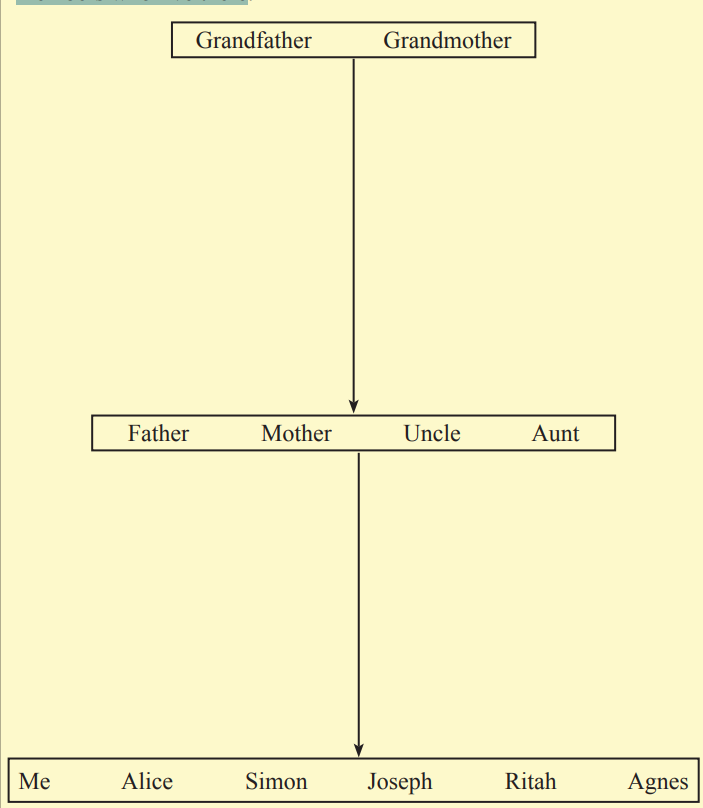
Briefly share these questions
1. How does Alice call Ritah?
2. Which of the family members share the same parents?
3. How will Simon’s children call those of Agnes?
4. Why do you think it is important to know our relatives?
5. Why is it unacceptable for related family members to marry each
other?
Activity 3
Draw the family tree of the members who live in your family. Use the
family tree to write a paragraph describing your family members. Shareyour family tree and description with other classmates
Describing traditional birth customs
Activity 1
Discussion
Share these questions among your fellow members.
1. Why do you think the birth of a child is celebrated in a family
and community?
2. Describe some of the customs and celebrations related to the birthof a child in your community.
Activity 2Carefully read and enjoy the passage below
The birth of a child is often welcomed with joy and jubilation. In the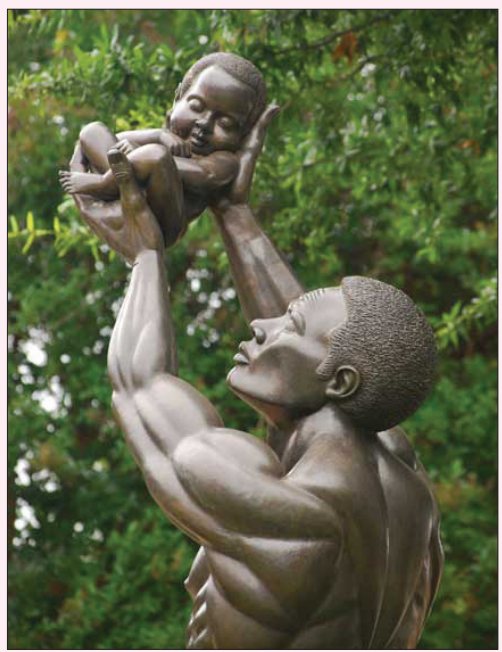
past, Rwandan parents looked forward to having a child, especially a boy,
to inherit the father’s position and property. This is no longer the case
today, because a girl child can now inherit property from her parents. To
Rwandans, children, especially the girls, are sources of wealth because
their parents will be given bride-price when they get married. Twins
are often accorded special treatment, and rituals are performed to keep
them alive. It is a common phenomenon in Africa for parents to have
many children, thus making the families generally large. In the past,
there were no established hospitals or maternity centres where womencould give birth.
Thus, children were born at home with the assistance of neighbours or
local midwives. Shortly after birth, the baby is given a thorough bath
with cold water, and a magical lotion is applied to protect the child from
evil forces.
For the first seven days after a baby is born, the mother and infant
remain in the house, attended to by family members. This is a period
of seclusion, meant for resting and recovering for the mother. It is also
a time of acclimatising the baby to the new environment. During this
period, relatives and friends give presents to the parents and the baby.
Fragile and helpless, the infant is susceptible to disease and illness.
Therefore, every precaution is taken to ensure that the baby is in good
hands. The baby sleeps in the same bed with the mother.
As in many African societies such as that of the Yoruba, names are given
to the baby on the eighth day. Names are important to the individual
and family as a mark of identity and also reflect the people’s cultural
beliefs and practices. The naming ceremony is a special and elaborate
social occasion for the family and the clan. In some societies, the clan
or lineage head provides personal names for the baby. The names may
reflect significant life experiences of the parents or the circumstances
under which the baby was born. Names in African cultures and customs
always carry specific meanings.
In Rwanda, the naming ceremony takes place outdoors in the evening
of the eighth day when family members and friends gather together to
celebrate.
The process begins with bringing the baby out into the public for the
first time. The parents present the baby to those present for the naming
ceremony. Because the mother and the baby have been in seclusion,
this is the first time the baby appears in public. Although the naming
ceremony is a social event, it also provides the opportunity for familyreunions.
Food and drinks are prepared by the relatives and all the village children
from three to ten years are invited to the naming ceremonies. They are
given a piece of land to cultivate. They use sticks that have the shape
of a hoe. After a few minutes, a male adult stops the farming activities
by throwing water on them. They immediately run home because it is
supposed to be raining. When they get home, they eat while the adults
are watching them. When they have finished, they are each asked to
give two names to the baby. All this is only ceremonial since none of
these names is considered in the final name choice. After everybody has
left, the mother gives names to the baby also, but as in the case of the
children, her names are not official either. The father is the last one to
give the names. He can do it just after the mother has finished, or he can
wait for early next morning to name the child. The father may select a
name from either the list provided by the young guests or the mother or
even give his own. There are no family names. He may select the nameof a grandfather, great grandfather, a nationalist or hero.
Exercise
Answer these questions about the passage you have read
1. Explain why in traditional Rwanda, the birth of a baby boy was
welcomed with great joy. Has the tradition changed in your
community? Is the birth of a girl child celebrated with similar
anxiety as that of a boy?
2. Compare the benefits of having a girl child and a boy child in
traditional Rwanda.
3. Describe the cultural rituals that were performed when twins were
born.
4. What was the use of the magical potion?
5. Explain the relevance of putting the mother and baby under seclusion.
6. Describe the role of children during the naming of a child.
7. How does the naming ceremony promote a platform for family
reunions?
8. What do you think is the relevance of inviting children to dine atthe new child’s parents’ home?
Describing death customs
Activity 1
Research
Carry out research about the customs related to death in your community.
What takes place when someone dies? What are the roles of the men,
women and children during this sad moment? Who says the traditional
prayers? Do people mourn? What happens during the burial? How is the
deceased buried? What happens after? Is the heir installed immediately?
Present your research in the form of an essay or a composition. Try to
make your composition interesting following the rubric of compositionwriting. You may share your compositions with other classmates.
Describing a traditional wedding
Activity 1
Discussion
1. Share these questions among yourselves:
(a) Have you ever attended a traditional wedding? Describe
what takes place among your groups.
(b) Do you think traditional ceremonies like weddings are
important in this modern era? Explain your opinion.
(c) Study the photographs in this text before reading and use
them to explain how traditional weddings are carried outin Rwanda.
Activity 2
Carefully read and enjoy the passage
A Traditional Rwandan Wedding
Marriage has always been a very important cultural institution in
Rwanda. Prior to and after the wedding ceremony there are a number
of traditional practices that take place. The nature of these practices has
changed over time, with several ceremonies being combined to take
place over a shorter period. However, many elements remain as they
were hundreds of years ago.
Many couples began with a relative of a bachelor pointing out a young
lady as a potential bride for him. The bachelor’s family would then
select a man as their representative who would act as the go-between
for their family and that of the bride to be. His role included intensive
research on the lady, including her ancestry as well as the conduct of
her relatives in society.
Following the research, the father of the potential groom, or a special
envoy selected by the family, would visit the girl’s father to declare the
intention of his son to marry their daughter. If the girl’s father accepted,
arrangements would be made as to when the introduction ceremony
would take place.
Next would be the ceremony where the representative of the bachelor’s
family officially requests the daughter as a bride. The ceremony is a battle
of wits often involving traditional tongue-twisters as well as riddles and
pranks from the girl’s side.
The family of the would-be bride, as well as the people of her
neighbourhood, were all consulted because the welfare of children isthe responsibility of the community even when they get married.
This was followed by the payment of the bride price. The bride price was
always strictly a cow, or several cows. Once the negotiations were over,
the bride’s side would invite the groom’s side to share a drink. Then,
before the groom’s side left, they would often be given a drink which
they were to enjoy on their journey home. In modern times, if one side
has travelled a great distance they may even be invited to share a meal
together with their future in-laws before they return home.
After the payment of bride price the families would meet again to discuss
the date of the wedding. In modern times, this is often done privately
between the bride, groom and their immediate families without involving
many parties.
Traditionally, before her wedding day, a bride would spend several weeks
in seclusion being cared for by one of her aunts. During this time her
aunt would give her advice on how to take care of her future family.
The bride would also undergo intensive beauty treatments, including
daily applications of perfumed cow-ghee with special herbs to give
her softer and smoother skin. She would also adhere to a diet regime
reserved for brides.
On the day of the wedding, the bride would be seated in a traditional carrier.
It would have two handles which would be placed on the shoulders of
four strong men who would carry her to the groom. After arriving at her
groom’s home, she would be taken inside and a special banquet in honour
of both the bride and groom would be held. The banquet would include
traditional Kinyarwanda dancing and singing.
The final ceremony involved the wife’s family visiting her at her new
home and bringing a number of items to help her settle in. Prior to this,
the wife would not have been seen in public and would have completely
refrained from any work. In this ceremony, the wife would make a meal
for her family and in-laws for the first time.
At the end of any visit, the visitors would be given a drink to take before
going back to their home.
The wife’s family would then journey home and the young couple would
begin their new life together.
(Source: Akaliza Keza Gar
Exercise
Answer these questions about the passage you have read
1. Do you support the view that “marriage is an important cultural
institution in Rwanda?” Explain your opinion.
2. Explain the role of the family representative on the bachelor’s side.
3. What do you think was the importance of paying bride price?
4. Why was a bride given special care by her aunt before the wedding
day?
5. Describe the wedding cultural practices that are still respected intoday’s modern wedding and justify their relevancy
Activity 3
Debate
Some people say that bride price should be abolished. Proponents of
this argument have looked at today’s modern woman as empowered
economically, politically and socially. What is your view?“Should bride price be abolished or not?” Express your opinions.
Talking about modern weddings
Activity 1
Discussion
Share with your fellow members a modern wedding you have ever
attended.
(a) Compare the clothes the couples put on, the food, drinks,
music and other articles with the ones of a traditional wedding
(b) What do you know about a civil or religious wedding in
Rwanda?
(c) Look at the photograph and use it to describe what takesplace during a modern wedding.
Activity 2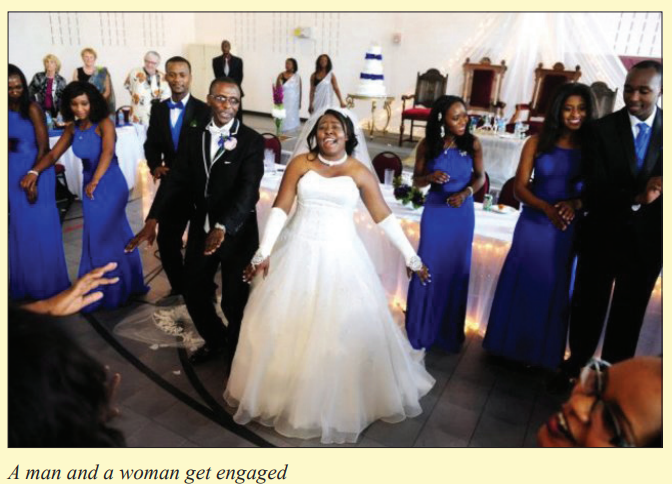
Read and enjoy the passage below
Rwandan weddings
Besides the day-to-day running of the shop, we’ve wanted to share
more about what makes Rwanda special, and what we’ve all been up
to outside of work as well as in it. Nothing comes any bigger than the
recent engagement of our assistant manager, Claire, which she wantedto share with all of you.
Most couples around the world have a single ceremony when they want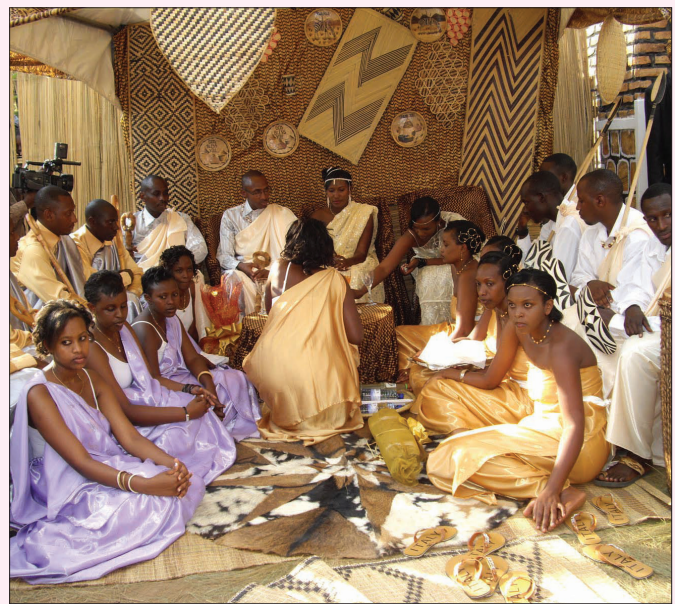
to marry. Not in Rwanda! Here people can have three: the traditional
engagement ceremony, a civil wedding (no wedding here is legal without
one) and a church ceremony. Years of planning and saving typically go
into all of this.
The bride price giving, or traditional engagement ceremony, used to be
the exclusive way Rwandans married. At its core, it is where the parents
officially acknowledge the couple and their wish to live together. Today,
it’s the first of the wedding events that take place over the course of a
month.
The bride’s house is set up with three tents in a U shape: one rectangular
one for the bride’s family, a second tent facing it for the groom’s family
and a smaller third one in between for the couple and their friends. Mostof the day’s activities take place in the centre of the U
First, the bride’s family and friends arrive to take their seats. It’s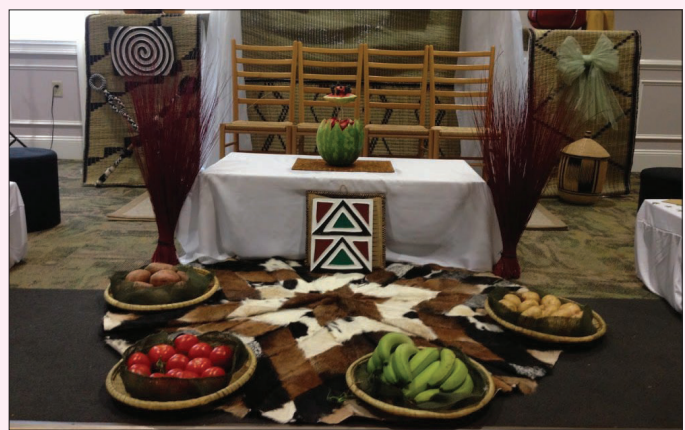
important for her guests to be more numerous than his, because she is
the host of the event. When all of her guests arrive, the groom comes
with all of his guests (family and friends – usually on a bus or two!).They bring gifts of beverages (soft drinks and alcohol) in large baskets.
Each family has a representative who speaks on their behalf, usually a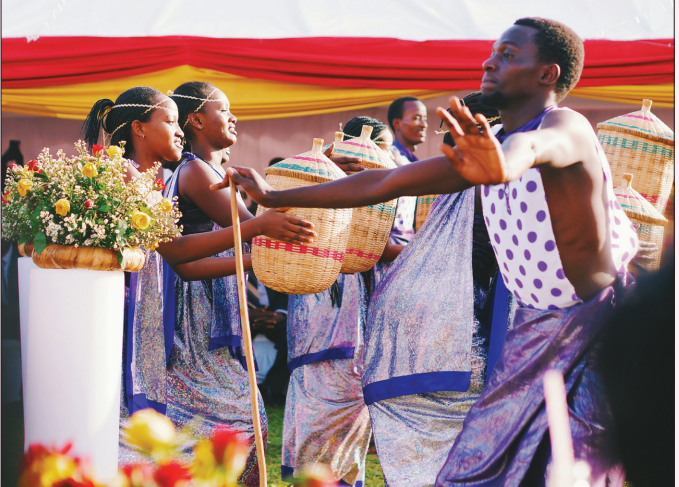
wise old man. They begin by praying and then by welcoming each other,
giving everyone a place to sit, drinks and making them comfortable. The
groom’s representative gives thanks and eventually gets to the matter of
their son being in love with a girl, which is when a sort of comedic duel
ensues. In fun, each representative tries to trick the other, a sort of test to
see if the couple will be well matched. The representatives discuss the
bride wealth of cows, symbols both of something to replace the loss of
a beloved daughter as well as the mixing of the families through their
herds (cows are very special in Rwanda). Poets come and sing of how
beautiful and special the cows for bride wealth are.
Finally, the bride is able to come out with her entourage, generally four
male guards, a girlfriend who is a mother, four other girlfriends and
two young girls.
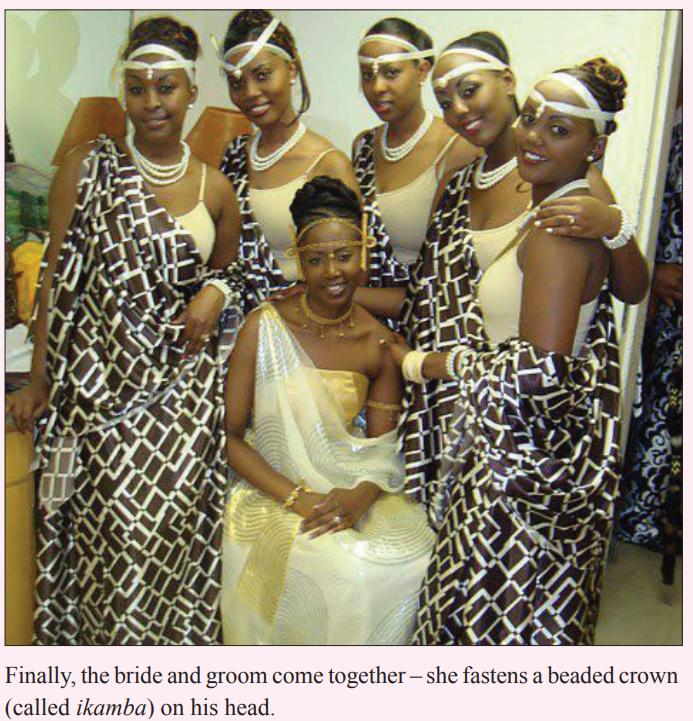
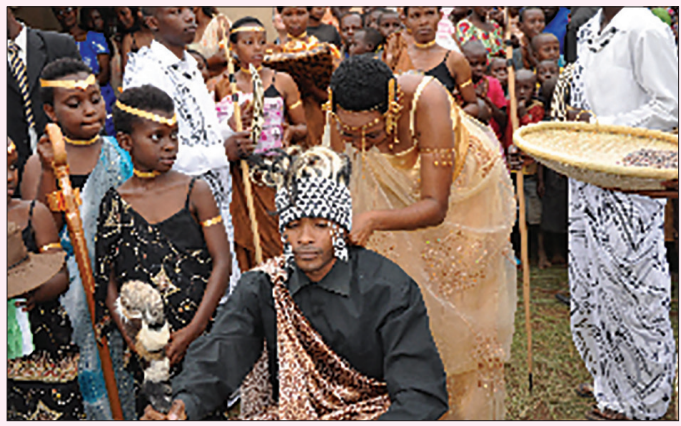
Once the bride and groom have introduced each other to their families,
the festivities can really begin with drumming and dancing. Luckily
for us, entertainment for this event was provided by Ingoma Nshya, the
famous all-women drumming group that created the Inzozi Nziza project!
This wedding was already special, but the bride being a drummer meantthat she was whisked up front to join in the music!
After the bride and groom have served food and drinks to each other in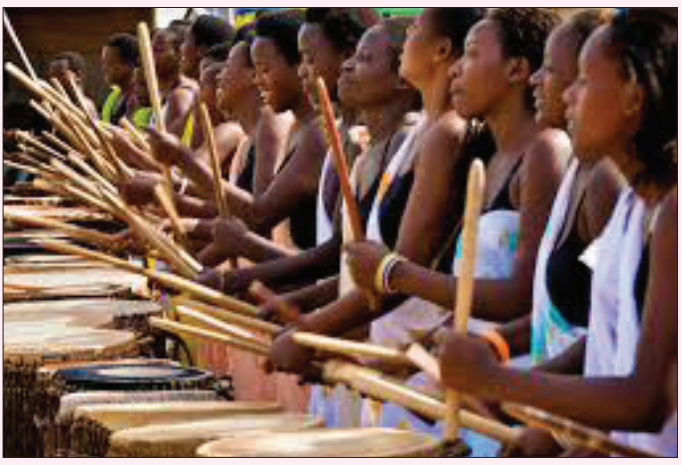
front of all, things calm down a bit and dinner is served to all guests.
There’s more music until the couple and attendants go inside to drink
milk and receive guests individually. All in all, a Rwandan wedding is
an experience not to be missed.
A word about the traditional costume
The bride and groom wear the costume pictured here exclusively for
weddings. The headband and beaded “sticks” worn on a lady’s head isa Rwandan-style crow
Exercise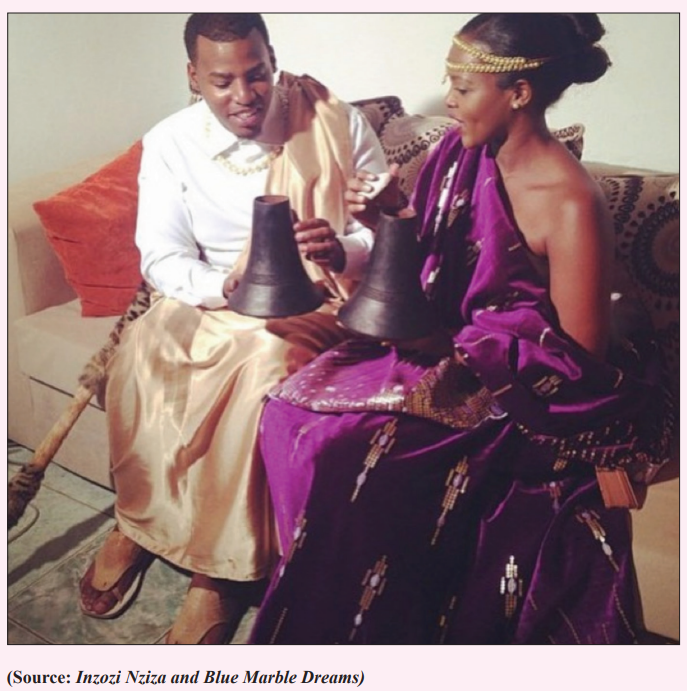
Answer the questions based on the passage you have read
1. Explain how each of the ceremonies contributes to a modern
Rwandan wedding.
2. Why is it relevant for the bride’s family to have many guests?
3. Explain the role of spokesmen and how they go about their duties
during a modern Rwandan wedding.
4. Weigh the symbolic meaning of cows as bride wealth.
5. Are there any similarities and differences you have noticed abouta traditional and modern Rwandan wedding? What are they?
Recounting a wedding
Activity 1
Composition
Describe elaborately in writing a wedding you have ever attended. Give
details of activities that made the wedding colourful.
Sentence connectors
Sentence connectors just like the phrase sounds, are words or a group of
words used to join or connect sentences to clarify the sentence and make
it meaningful. Sentence connectors are typically used in compound or
compound complex sentences.
Activity 2
Gap filling
Your teacher will read to you a passage. Fill in the missing sentence
connectors in the blank spaces to complete the paragraph below.
My friend and I were ushered in .................. we sat in the best position;
opposite each other to enable us to see all that was going on, ..................,
heads of the different families, in particular the men, went ahead to
discuss why really their children would get married. Thereafter families
were introduced and in appreciation, there was the exchange of presents
that made them feel at home. At this juncture, the groom was introduced
by the aunt to the congregation which was ............ the giving of bride
price to the girl’s parents. The bride price is in the form of cows .............worth their daughter
Later on, we were surprised by the bride’s procession. She was escorted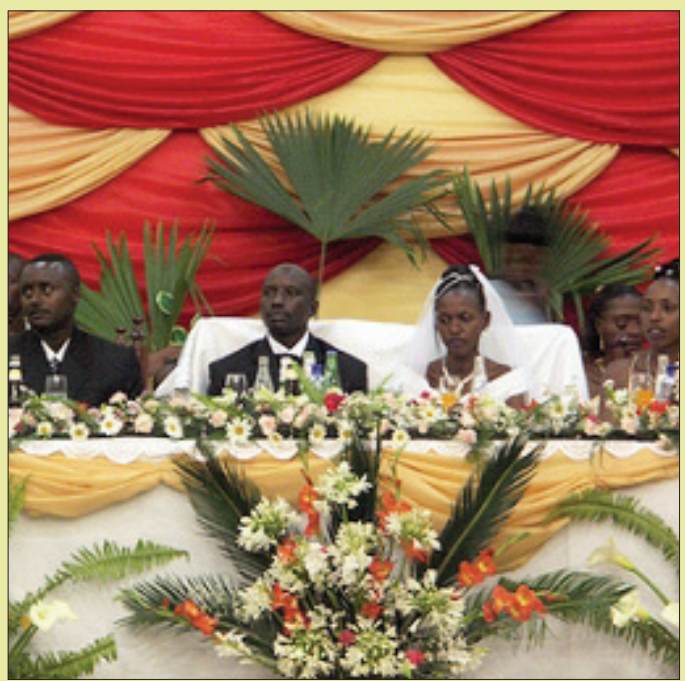
by women both young and old. They came with gourds of milk that were
to be given to the groom’s family .................. were traditional dancers
that made the occasion beautiful. The bride was dressed in beautiful
traditional wear .................. her bridal team that carried the gifts to the
groom’s family. Tradition has it that four spear men have to guard the
bride. After that the bride and groom were ushered into their special
tent .................. that the two were ready to get married in church. A lot
of dancing and eating .................. event till people got tired and went
home. It was such a great event and it’s something I would love to haveon my introduction day.
The bride and the groom feeding the guests from ‘ibyansi’. This activity crowns
the wedding ceremony
Source: Rwanda on line/modern wedding
Activity 3Use the sentence connectors in your own sentences.
Exercise
Answer these questions about the passage you have
filled in and read
1. Describe the materials from which the bride’s traditional wear is
made.
2. If a visitor to Rwanda asked you about a Rwandan wedding, how
would you describe it to him or her?
3. Why do the families sit opposite each other or her?4. Why do you think the groom is introduced to the parents of the bride?
5. Of what significance are the gourds of milk given to the groom’s
family?
6. Why do you think four spear men should guard the bride?
7. Explain the importance of food, drinks and music in a wedding?8. Of what relevance is the church or mosque in a wedding?
Activity 4
Research
Through using the internet or inquiring from your community members,
carry out research about how either a traditional or modern wedding is
conducted in other communities elsewhere in the world, where customs
are different from a typical Rwandan wedding. Describe what takes
place during the ceremony while comparing and contrasting it with the
Rwandan wedding. Share your compositions with other classmates forfurther discussion and comparison of your research findings.
Talking about work distribution in the family
(gender roles)
Activity 1
Discussion
Share your opinions about the following issues.
1. How do you view a woman today?
2. Do you think women enjoyed the same privileges in the past as
they do today?
3. What are some of the roles women play today that they used not
to in the past?Activity 2
Read the passage carefully comparing work distributed
between men and women in the past and today inRwanda
Marriage, Motherhood, and Division of Household Labour
Gender roles in traditional Rwanda were structured around a households
division of labour that allowed women substantial autonomy in their
roles as child-bearers and food producers but preserved male authority
over other family affairs. Because their biological capacity to bear
children and their roles as mothers strongly determined women’s status,
their influence was ultimately captive to cultural interpretations of these
capacities. As a result, Rwandan women navigated a cultural space that
had the potential to both enhance and suppress their power within the
household and family.
Several traditional Rwandan expressions refer to a connection between
women’s leadership and a strong household. Men, however, remained
the ultimate arbiters of most family decisions. As Reseau des Femmes,
a women’s civil society organisation, notes “Rwandan tradition holds
that, as the chief of the household, the man is respected by all members
of the family. Important decisions are therefore made by him, even if
he sometimes consults his wife before making them.”
Importantly, gender roles in the home differed according to the social status
and material wealth of the family. In the words of one older gentleman:
“In the rich homesteads, women reflected high levels of management and
control of family affairs.
Men actually never entered the backyard, and a man who tried to know
what went on there was considered greedy, uncultured, and unmanly.”
The wealthier certain men became, the less time they had to control
family affairs as they sought to demonstrate their allegiance to the king
(or others with political status) in order to secure protection for propertyand the promotion of their own social status.
Thus, their wives had significant autonomy and control over the family
property, household workers, and children.
These women also maintained personal property, such as cows, that they
could use to acquire friends and a loyal, grateful clientele. An expert
noted: “As [they] climbed the social ladder, women’s value increased,
as opposed to women in the lower-class levels.”
In poor families, wives still controlled internal family issues, such as
the use of farm proceeds, but men more closely oversaw and managed
the family property, leaving women with less control over household
decision-making. Men in poor homesteads took part in direct production
of the family’s wealth. While this meant that men assumed more control
over property, it also often resulted in a more equitable division of
household labour, with men going to gardens with their wives, assuming
the most difficult farming roles, and tending livestock.
Traditionally, Rwandan women were not permitted to own land. If a
male head of household died, property passed to male heirs or to the
man’s brothers. In the case of divorce or the husband’s death, a woman
had no claim over the family property if she had not borne children; she
would quietly return to her family of origin or marry into another family.
Women with children were required to marry a brother of the deceased
in order to retain their status as members of their marital family.
Women may have influenced day-to-day decisions regarding the
management of land, but they had little ability to direct larger decisions
regarding the sale or lease of property. Because men were thought to
make occasionally abrupt, irrational decisions, cultural norms urged
men to consult their wives before finalising any sale or gift. One expert
stated, “Women decided who gets a cow from the family. Even giving
cows to children required that the wife be consulted first.
When the family bull was to be given (lent) to a neighbour or friend for
the purpose of mating, the woman had to give her consent first. In the
cultural sense, women were heads of their families.”However, such gestures were more of a formality than requirement; a
woman’s failure to consent to such matters did not prevent a man’s action.
Cultural prohibitions against making family matters public prevented
women from disputing land ownership, a problem which continues today,
despite the 1999 law establishing women’s right to inherit and own land.
Household gender roles also varied by region. Some interviewees
referred to a perception that women in the central and southern parts of
the country were treated with greater gentleness. Women were not meant
to perform hard chores such as building houses or collecting firewood and
water, and they did not work alone in their gardens; rather, they always
worked hand in hand with their husbands, especially in poor households.
Men were responsible for more physically demanding tasks, such as
clearing the bush and the initial tilling of the land, while the women
did the less labour-intensive tasks of planting, weeding, and harvesting
the crops. To some, this protective tendency signifies that women were
treated as the weaker sex and seen as unable to manage hard tasks. But
to others, this division of labour demonstrated respect, and a man whose
wife engaged in hard chores was viewed as an irresponsible husband.
Rwandan culture placed great importance on marriage, and married
women and men were given special respect and recognition in society.
As with other cultural practices, marriage, in some ways, recognised
and respected women’s independence and, in other ways, subordinated
women within a patriarchal system of authority. In the days preceding a
wedding, for instance, aunts and other elderly women counselled a bride
on the duties of marriage. This advice generally focused on the woman’s
responsibility to respect her husband and his family and emphasised her
obligation to be subservient to her husband.
Married women were no longer permitted to act as girls, climbing trees
or milking cows. In the northern region, though, where the bride price
could be exorbitant, a woman was also expected to recover the cost
incurred by her husband in paying her family to legalise a marriage.
The husband provided a combination of sheep, goats, cows, hoes,
pots, local beer, and money; the wife was then expected to labour ascompensation to her husband.
On the other hand, a Rwandan bridegroom was required to leave his
family and live with his bride in her family’s homestead during the first
days of marriage. This practice was intended to help the girl adjust to
her husband before she made the transition to his home and assumed the
responsibilities of wife and mother. It also provided an opportunity for
the bride’s family to evaluate the capacity of their new son-in-law to care
for their daughter. During his stay at the bride’s home, the bride’s family
required the groom to work, take part in all male chores, and display a
high level of discipline. If he did anything considered offensive, he could
lose his wife and be sent home in disgrace. Not much is known about
the frequency with which this practice was employed in pre-colonial
Rwanda, or how often families sent young men home. The stories persist,
however, as cautionary tales.
Social taboos and traditions arose to reinforce respect for motherhood and
to protect women and children from danger or abuse. The word “mother”
also has connotations of “creator” and “life giver”. Her family and in-laws
would pamper and exempt a woman from certain chores during pregnancy
and immediately after delivery of a child.
On some occasions, chiefs would punish men who did not conform
to these expectations. In poor communities, neighbours guaranteed a
steady supply of milk to a woman who delivered a baby. One Rwandan
woman in her sixties described society’s respect for women in this way:
“While traveling with a child, a woman never had to carry milk for the
baby as any home she approached along the way welcomed her and
provided her with milk for the child, and for herself.”
Gender roles in the public sphere
women’s public roles in traditional Rwandan culture perhaps provide
the more relevant context for evaluating the extent to which indigenousgender practices underlie women’s modern political achievements.
As with women’s household roles, however, accounts from interview
participants and available literature present conflicting attitudes
regarding women’s place in traditional politics. In some ways, women’s
leadership and participation in public life were respected and solicited,
but they were often also rejected or feared.
Although Rwandan culture is sometimes celebrated as exceptional
among African cultures for promoting women’s influence in the public
sphere, in many cases women were expected to defer to men or to wield
influence indirectly through their husbands. Traditionally, women did not
speak publicly, especially in the presence of men. A woman who dared
challenge men in public was considered insolent. In interviews, many
elders—who continuously referred to Rwandan traditional culture’s
respect for women—contended that the major limitation on women was
lack of freedom to express themselves in public.
Women were not allowed to participate directly in public deliberations;
rather, they were expected to play an indirect role in the customary system
of justice. Through their personal networks, women would lobby their
husbands and influence court decisions by proxy.
Women’s absence from public proceedings such as traditional court
hearings is evidenced by the local word for witness which translated
literally means “a man”. Only recently did the term for witness change inorder to make it gender-neutral and formally include women witnesses.
Activity 3
Note making and summary
In the table below, write notes comparing the roles of men and women
in traditional and modern Rwanda. Do the work in your exercise book.
Activity 4
Use your notes to write a summary comparing the roles men and women
played in the past with the roles they play today.
“Used to”
Activity 5
Use the notes from your table to write sentences using ‘used to’
comparing the roles of men and women in the past with today’s roles.
For example:
(a) Men used to clear the land.
(b) Women used to stay at home doing household chores.
(c) Now women and men share household roles.
Activity 6
Debate
Do you support the view about the changing roles where women today
are playing roles which were originally played by men? Explain youropinions
